Laying vinyl tiles on the floor
Vinyl tile is a type of floor covering that includes vinyl and small natural stone. Thanks to the materials used in the production, the vinyl floor is more resistant to environmental influences than linoleum, for example. Cladding the floor with vinyl tiles is usually carried out in the kitchen, hallway, bathroom. This is due, first of all, to high moisture resistance and rather simple maintenance of such a floor covering. The technology of laying vinyl floors is significantly different from facing the floor with ceramic, stone tiles.
Content
- Standard start – preparation
- What is required for the device
- Laying Vinyl Tiles
- Photo of interiors with a vinyl floor
Standard start – preparation
The durability of the floor covering made of vinyl tiles is ensured by the implementation of all preparatory work. It should be noted that vinyl floors should only be laid on a flat, clean and dry surface. A concrete floor, a leveling screed made of light concrete, a base made of waterproof plywood can serve as such a base.
It is further recommended that a primer primer coat be applied to any type of substrate. To check the evenness of the surface using a wooden rail. The finished base can be considered flat if there is a distance between it at a particular point and the control rail of less than 2 mm.
Before starting work, it is necessary to allow the material to rest, level out and acclimatize. In the room in which the vinyl tiles will be laid, the temperature should be observed at a level of 20 degrees, but not lower than 15 degrees. Providing such conditions is necessary to achieve good elasticity of the new floor. In addition, this will avoid swelling of the material, adhesive shrinkage and other deformation changes..
Vinyl tile does not allow moisture to pass, if it is laid on an insufficiently dry surface, the remaining moisture will accumulate under the material, causing damage to the coating. Therefore, it is necessary to maintain the relative humidity of the base below 3%. Under these conditions, a concrete base in wet rooms will need waterproofing..
What is required for the device
The following tools and materials are required for laying vinyl tiles:
- Roulette for accurate measurements when laying;
- Marking cord;
- Blade knife for flooring;
- Pencil;
- Metal square (protractor);
- Spatula for even distribution of glue;
- Smooth rubber roller;
- Sponge or damp cloth for cleaning glue residue from tiles;
- Glue;
- Vinyl tile.
Laying Vinyl Tiles
Using simple measurements, you need to find the center of the room. Using a tape measure, we calculate the middle of two opposite walls. Then we connect them together with a marking cord. Next, we find the middle of the planned line and use a metal square to measure the right angle. Draw the second line perpendicular to the first. Along the outlined lines it is necessary to lay vinyl tiles.
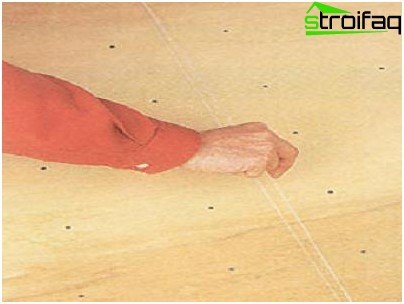
Drawing lines to determine the center of the room
Work starts from the center of the room. This is due to the fact that the inner walls may not have strictly right angles, and when laying from one of these walls, cracks may appear along the others. Make sure that the edges of the tiles follow the marked lines..
When laying, avoid excessive air entering under the arranged coating. To ensure uniform application of glue in the required amount, you should use a special notched trowel having interchangeable blades to achieve the desired glue consumption.
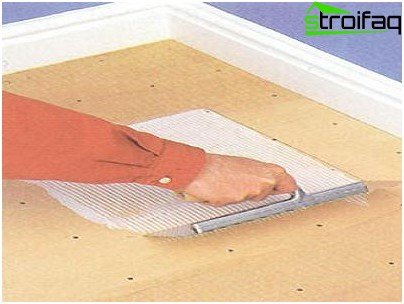
Glue application with a notched trowel
After the tile is glued, it should be pressed down firmly with your hands and rolled with a ramming rubber roller to remove the bubbles that have arisen, and better and more uniform gluing. Excess glue that appears during installation must be removed with a sponge or cloth dampened with soapy water..
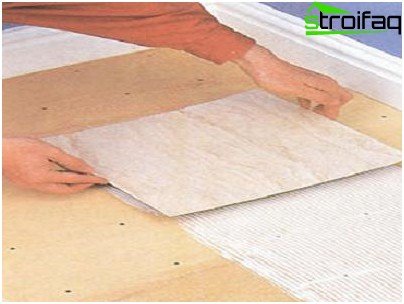
Laying Vinyl Tiles
Self-adhesive vinyl tiles are laid in a simpler way. To do this, just remove the film that protects the back side and firmly press it to the surface of the base.

Self Adhesive Vinyl Tile
Vinyl tile is quite popular. But, if there is a question about whether to install vinyl floors – reviews about this flooring will help to make the right choice. Vinyl flooring – non-slippery, withstands sharp blows, has good soundproofing properties.
There are many design solutions that use vinyl floors as flooring: a photo selection of interiors will help determine the most suitable option for any room.
Photo of interiors with vinyl floor
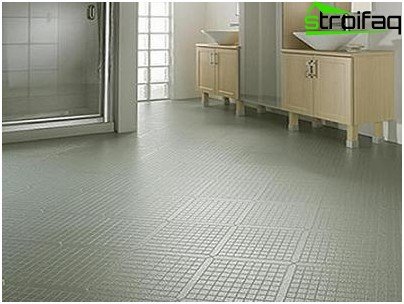
Vinyl tile in the bathroom
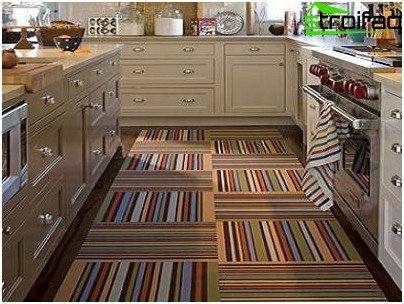
Vinyl tile in the kitchen
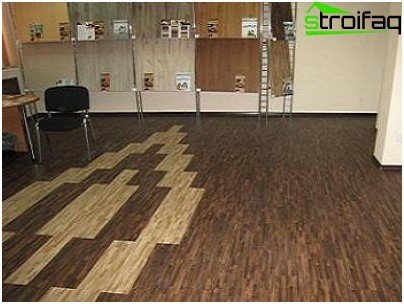
Unusual design solution using vinyl tiles
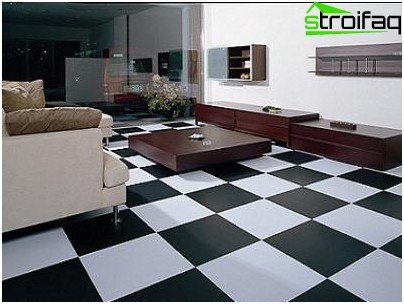
Vinyl tile in the living room






